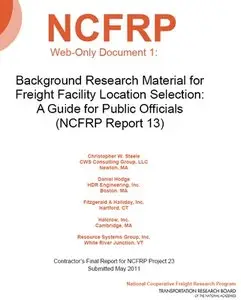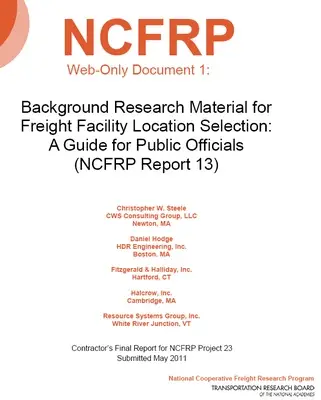Background Research Material for Freight Facility Location Selection: A Guide for Public Officials
National Cooperative Freight Research Program (NCFRP) Report 13. Research and Innovative Technology Administration
TRB, NAS Press | 2011 | ISBN: n/a | 125 pages | PDF | 2 MB
National Cooperative Freight Research Program (NCFRP) Report 13. Research and Innovative Technology Administration
TRB, NAS Press | 2011 | ISBN: n/a | 125 pages | PDF | 2 MB
This issue provides background material used in the development of NCFRP Report 13, which describes the key criteria that the private sector considers when making decisions on where to build new logistics facilities.
1) Summarize public- and private-sector understanding of the issues and potential challenges involved in freight logistics facility location decisions, whether initiated by the public or private sector.
2) Review previous research on private-sector site-selection criteria. Identify and classify the freight logistic facilities (e.g., intermodal freight facilities, distribution centers, warehouses, transloading facilities, and cross docking facilities) that should be investigated and their role in goods movement. Describe international and domestic freight types, the logistics chains that support each, and how they interact with the overall transportation system.
3) For each freight logistics facility class identified in Task 2, develop a case study and specify the data and information required, including the types of freight flowing through such facilities and the support functions provided at the facilities, to complete the research objective. Compare case study information requirements to previously available research, and define the information gaps. Identify typical public and private costs, benefits, and transportation system impacts of these facilities.
4) Four months after contract approval, submit the results of Tasks 1 through 3 and a stakeholder review plan (see Task 6 and Task 7) to the project panel in a webinar.
5) Conduct research required to eliminate information gaps identified in Task 3 and address any additional facilities or criteria identified by the panel. Develop an outline for Task 7.
6) Upon project panel approval, develop the guide and consult with applicable private-sector decisionmakers for feedback. Review the findings with public-sector officials and gather feedback.
7) Submit the final research report with an appended stand-alone document that public agencies can use as a guide to better inform the freight infrastructure facility recruiting and investment strategy and process.
Table of Contents
Introduction
1.1 Background
1.2 Purpose
1.3 Approach
1.4 Organization
Literature Review
2.1 Overview
2.2 Introduction to Site Selection
2.3 Freight and Logistics Trends
2.4 Corporate Location Trends for Freight-Intensive Businesses
2.5 Economic Development Implications
2.6 Summary
2.7 References
Survey of Public and Private Perspectives
3.1 Overview and Key Findings
3.2 Methodology
3.3 Public Sector Responses
3.4 Private Sector Responses
3.5 Conclusion
Freight Logistics Facility Types
4.1 Overview
4.2 Distribution Centers (DC)
4.3 Port
4.4 Intermodal Terminals
4.5 Bulk or Transload Terminal
4.6 Integrated Logistics Center (ILC)
4.7 Hub Terminal
4.8 City Terminal
4.9 Facility Type and Siting Decisions
The Location Selection Process
5.1 Overview
5.2 Planning and Strategy
5.3 Network Modeling
5.4 Location Screening
5.5 Field and Site Analysis
5.6 Cost Modeling
5.7 Incentives Negotiations
5.8 Final Selection
Key Criteria and Data Requirements for Facility Location Decisions
6.1 Overview
6.2 Ability to Access Key Markets or Customers
6.3 Interaction with Transportation Network
6.4 Labor and Workforce
6.5 Total Cost Environment
6.6 Availability and Cost of Suitable Facilities
6.7 Utilities
6.8 Permitting and Regulation
6.9 Tax Environment
6.10 Public Sector Assistance and Incentives
6.11 Climate and Natural Hazards
Current Dynamics Impacting Facility Location Decisions.
7.1 Changing Role of the Freight Facility
7.2 Organizational Factors and Comprehensiveness
7.3 Computer Model Use and Sophistication
7.4 Changes in Global Sourcing
7.5 Fuel Costs and Environmental Factors
7.6 Network Congestion
7.7 Competition with Other Development Types
Case Studies of Freight Logistics Facilities
Part 1: Framework for Assessing the Economic and Transportation Impacts of Freight Facilities
8.1 Transportation Impacts
8.2 Economic Impacts
8.3 Costs
Part 2: Introduction to the Case Studies
8.4 Virginia Inland Port Case Study
8.5 Rickenbacker Intermodal Rail Facility – Columbus, Ohio
8.6 Savage Safe Handling Case Study
8.7 Family Dollar Distribution Center – Marianna, Florida
8.8 Murphy Warehouses Case Study
8.9 AllianceTexas Global Logistics Hub – Fort Worth, Texas
8.10 Old Dominion Freight Line, Inc. – Morristown, Tennessee
8.11 Summary of Case Study Findings
The Critical Roles of Groundwork and Collaboration
9.1 Laying the Groundwork
9.2 Public Sector Assistance and Incentives
NCFRP 23 – Glossary of Terms
Appendix A: Public and Private Sector Data Collection Instruments (DCI)
Questionnaire to Evaluate Current Public Understanding
Questionnaire to Evaluate Current Private Understanding
Appendix B: List of Interviews
with TOC BookMarkLinks



